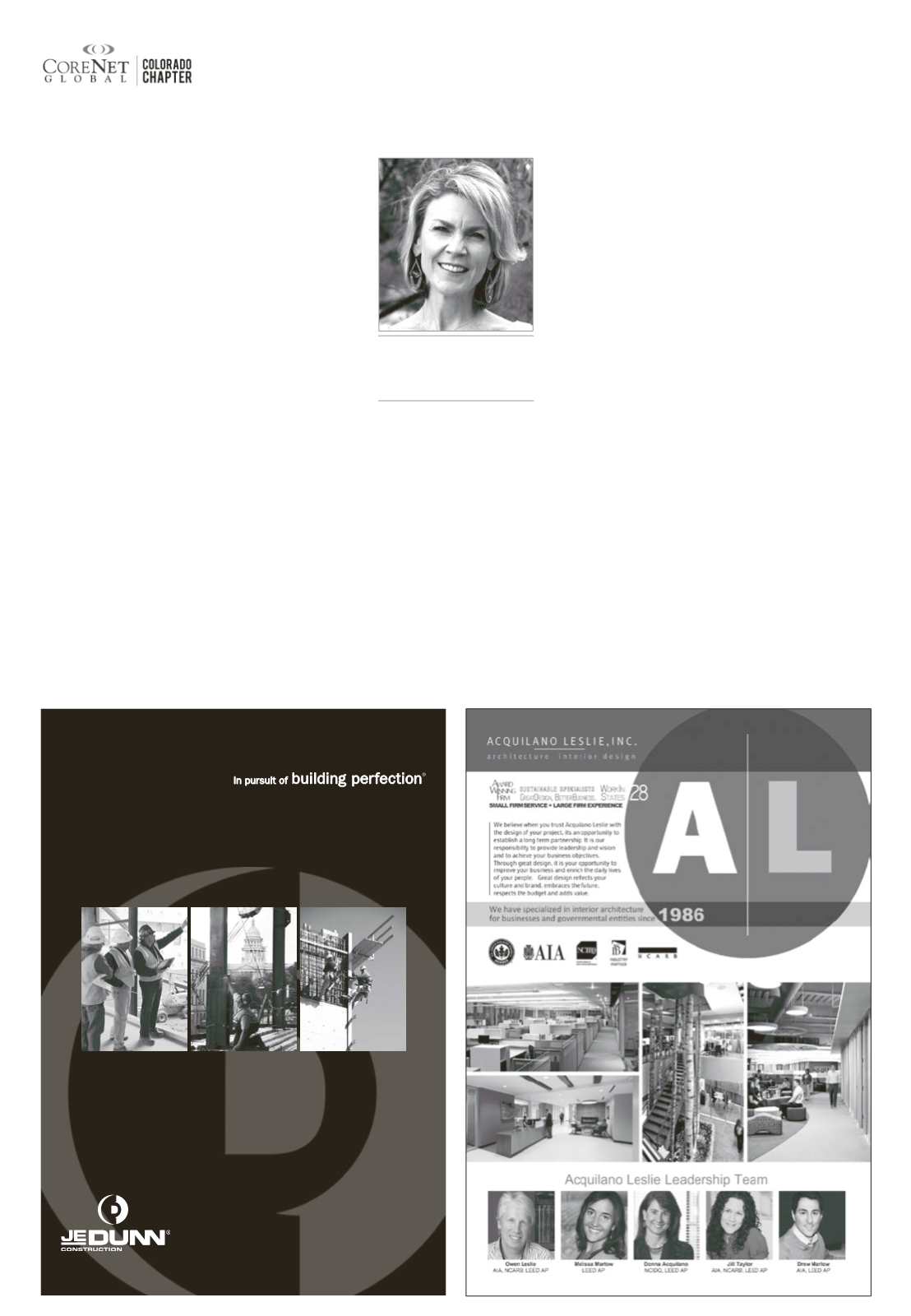
November 19-December 2, 2014 —
COLORADO REAL ESTATE JOURNAL
— Page 3AA
Spotlight
JE Dunn leverages advanced technologies,
collaboration, and Lean practices to provide
unmatched preconstruction and construction services.
We work Smart. We think Lean.
WE ARE
BUILDERS
DENVER + COLORADO SPRINGS
R
ecent developments
in green building are
redefining certification
trends – no longer is LEED
the only choice for certifying a
building or tenant improvement
project. As building owners,
landlords, tenants, developers,
architects/designers and project
managers continue to place a
priority on stewardship to the
environment, with that comes
the ability to utilize a variety of
strategies and tools to certify
projects.
While all certification metrics
are based on the roots and
principles of sustainability,
each has its own nuances
and unique identifiers. It
is important to identify the
defining characteristics of each
certification to determine its
suitability for the specific project
type under consideration.
Considered the pioneer of
green building certification,
LEED (Leadership in Energy
&Environmental Design)
is a program that promotes
renewable energy, supports
healthy buildings and recognizes
innovative thinking regarding
how buildings and interior
spaces are designed, constructed
and maintained. To achieve a
LEED certification via GBCI/
Green Building Certification
Institute, projects must meet
defined prerequisites and earn
the necessary points toward the
desired level of certification.
Rating systems include multiple
project types, such as Building
Design & Construction, Interior
Design & Construction, Building
Operations & Maintenance,
Neighborhood Development and
Homes.
Beyond building-centric design,
The Living Building Challenge™,
an alternative to LEED, is a
certification tool + advocacy
tool that supports an ideology
of solution-based green design.
Based on seven performance
categories known as Petals
(Place, Water, Energy, Health &
Happiness, Materials, Equity and
Beauty) with each Petal being
subdivided into 20 Imperatives,
a new approach to project
performance is being defined –
whether as new construction or as
an existing building.
Place strengthening benefits
are effectively managed through
the certification process known
as
Energy Star
and the use of its
EPA created Portfolio Manager
measuring EPA mandated
standards. This online tool
allows for building owners and
landlords to measure and track
water, energy and greenhouse
gas emissions. Known as the
mark of efficiency, Energy
Star certification is annual
and is verified by a third party,
thereby creating a credible and
measurable tool for multiple
project types across multiple
geographies.
With an evidence-based
approach, the
WELL Building
Standard®
is in its pilot phase.
Researched by architects,
scientists and doctors who
promote that green building/
health/wellness go hand in
hand, this certification sets
performance categories utilizing
seven category contents (Air,
Water, Nourishment, Light,
Fitness, Comfort and Mind) with
commercial, institutional and
residential developments being
eligible for certification. This
certification process encourages
design professionals to focus on
the integration of architecture
and wellness and defines a series
of technology enhancements
and systemized performance-
based measures. Like LEED, it
also is certified by GBCI/Green
Building Institute via a formal
collaboration.
As another alternative to
LEED,
GreenGlobes
uses an
online questionnaire via an
interactive process that also
includes a third-party assessment
and site visit. Green Globes has
emerged as a viable option to
LEED with automated reporting
that can potentially expedite
a sustainability designation
if all metrics are met and
memorialized. Utilizing data from
actual buildings, versus modeled
structures, the Green Globes
certification process directly
encompasses ideas such as
geographic design considerations,
space optimization, energy-
efficient technologies, operational
aspects and the impact of the
building occupants.
A multisensory environment
approach and innovative design
principal known as Biophillic
Design offers the opportunity
to connect people + nature
and utilizes design strategies to
provide the ability for nature
to inspire architecture. Often
called a “paradigm shift,”
Biophillic Design is a design
philosophy (rather than an
actual certification process) that
challenges nature to not be an
afterthought in design. As quoted
by Rick Fedrizzi, President, CEO
and Founding Chairman of the
USGBC/U.S. Green Building
Council: “When nature inspires
our architecture – not just how
it looks, but how buildings and
communities actually function,
we will have made great strides
as a society.
Biophillic Design
provides us with tremendous
insight into the ‘why,’ then builds
us a roadmap for what is sure to
be the next great design journey
of our times.”
Another certification process,
although less popular to the
commercial real estate industry,
is
Greenroads
with specificity
to roadway design and bridge
construction. A proponent
of sustainable transportation
infrastructure, the Greenroads
Rating System is a collection of
best practices that earn credits/
points with four different
certification levels available.
In addition to the sustainability
trend in the U.S., certification
processes are making their way
to Europe via a metric known
as
BREEAM
– an acronym for
Building Research Establishment
Environmental Assessment
Methodology. Encouraging
designers, landlords, developers,
tenants, project managers and
building owners to think about
low-impact design by measuring
a wide range of standards from
energy to ecology, BREEAM has
case studies spanning the globe
showcasing their environmental
assessment methodology.
Whether it be reducing
the energy use of buildings,
improving the conditions in
which people work, incorporating
natural daylight and ventilation,
providing renewable energy
sources or connecting people
with nature – most certification
processes and methodologies
have similar criteria. As
sustainability metrics evolve
and because multiple credible
certification alternatives exist, the
sustainability community can now
choose the certification strategy
that best meets their project’s
needs.
Megan Walsh, LEED
AP BD+C
Principal, Catalyst Planning Group


